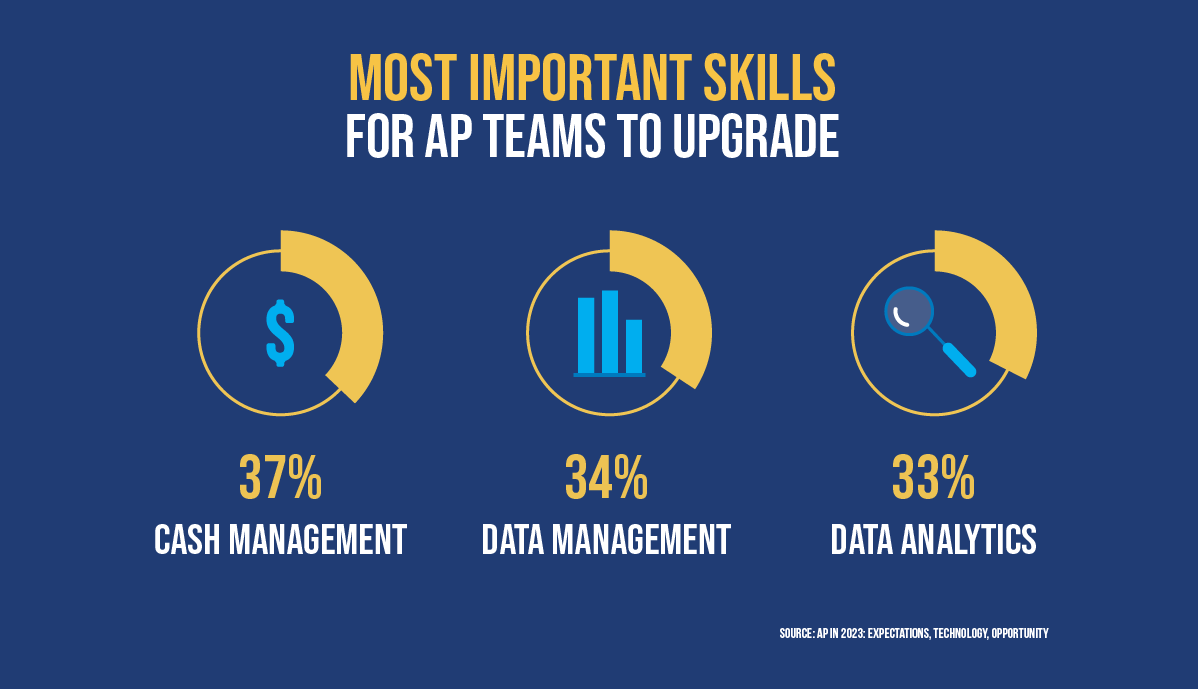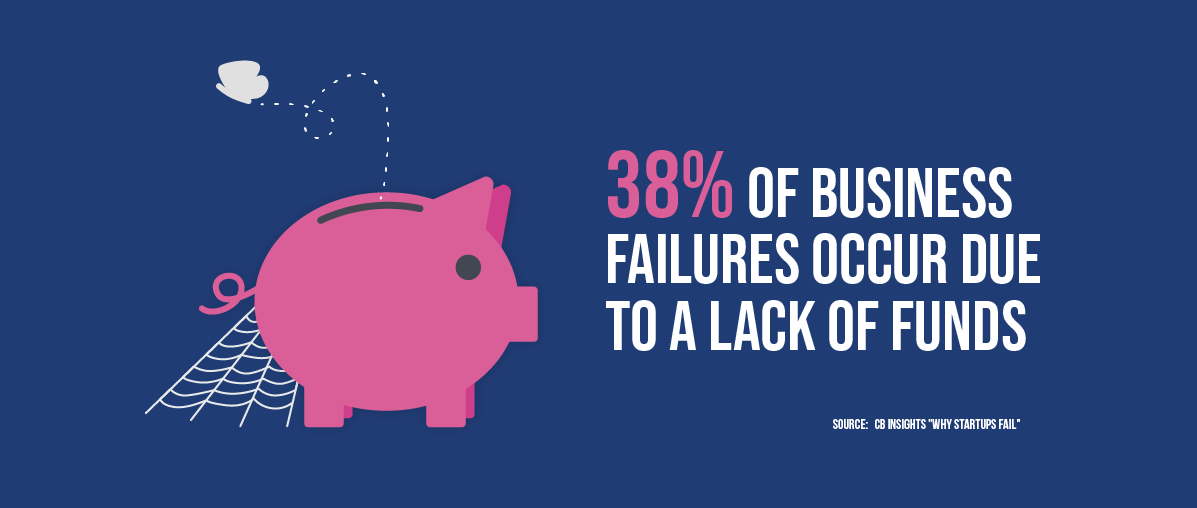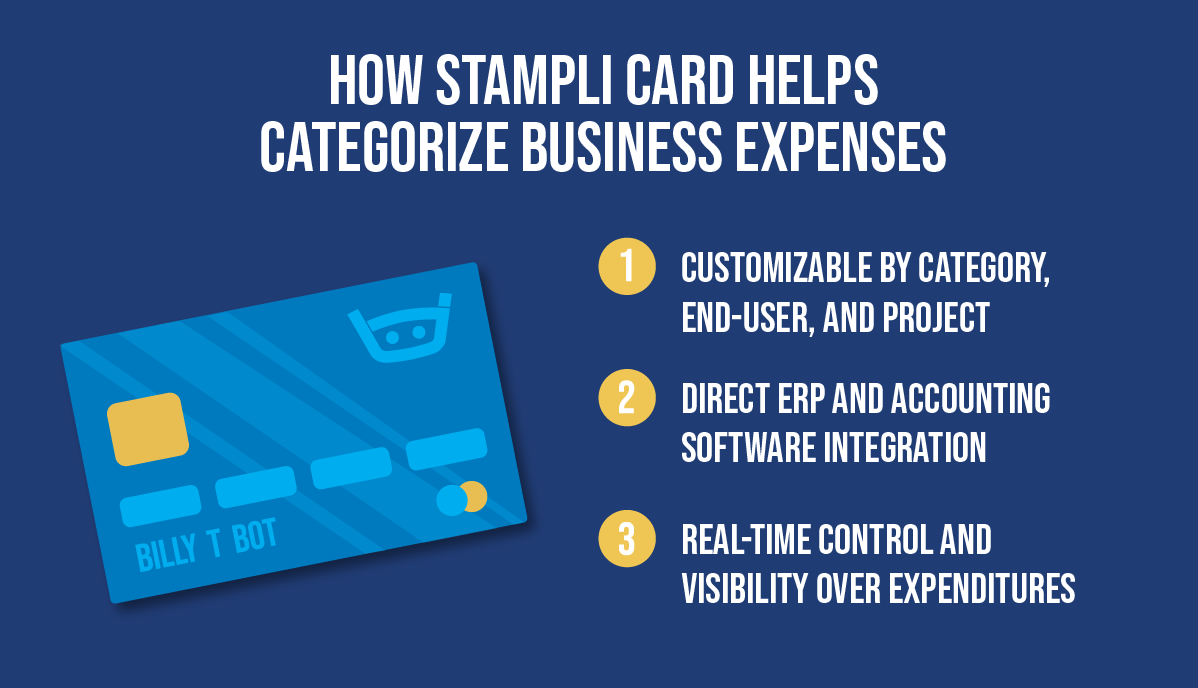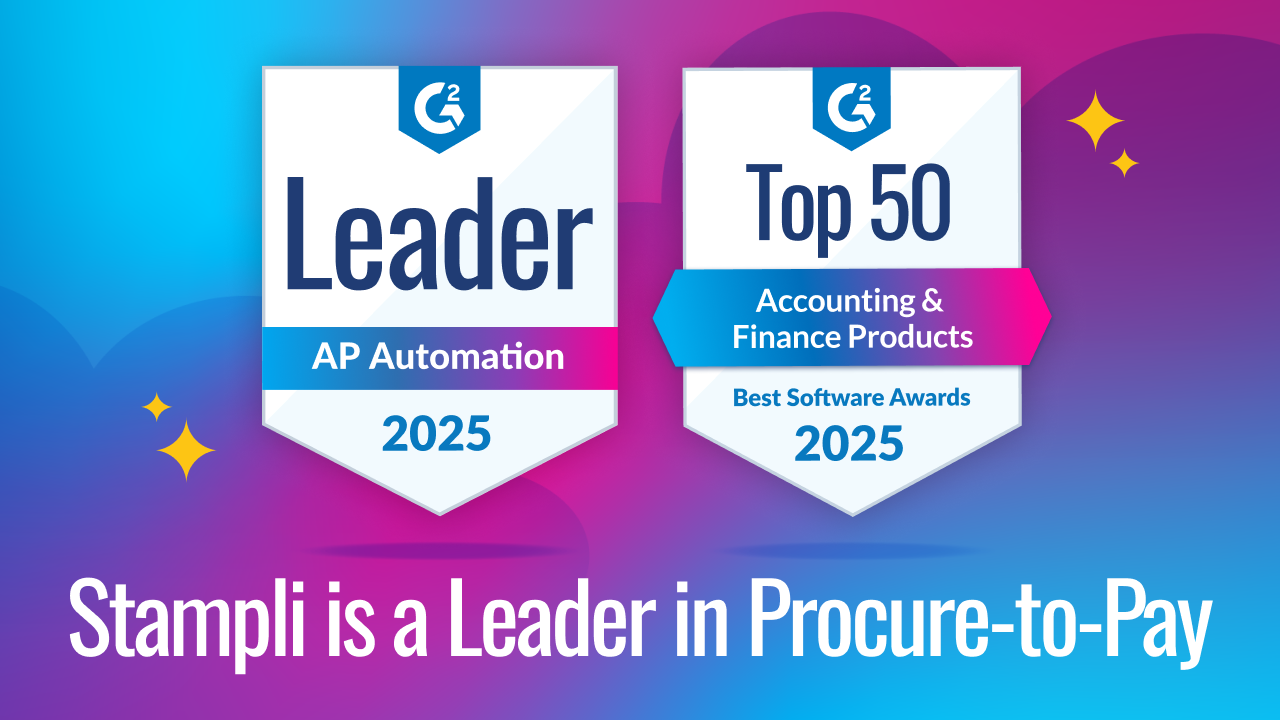How to Categorize Expenses: Why Your Strategy Should Include Payment Cards

Lack of attention to business expenses may be costing business owners big.
In 2021, Americans submitted 5.4 million new business applications, the most ever in a single year.
By 2031, only one-third (1.8 million), will still be in business.
Out of those who will fail, 38% of the time it will be because they ran out of money.
In business, expenses are inevitable, but failure needn’t be. By tracking, managing, and controlling your spending categories, you can improve cash flow management, take advantage of business tax deductions, and be prepared for ups and downs.
Read on to learn how to build business resilience and save money by categorizing expenses. We’ll look at the types of spending categories, tips you can use to manage them, and why it’s essential to include expense management and payment cards.
What are common business expense categories?
Business expenses are incurred to operate a company and make sales. To make it easier to track, understand, and manage expenses, businesses usually group related expenditures into categories. For example, a business might group salaries, benefits, and bonuses into the payroll category.
What are tax-deductible expenses?
The IRS allows businesses to deduct expenses for “ordinary and necessary” business purposes from their income taxes. Deductible expenses will be different for each business, depending on their industry and structure. You can find the rules for deducting expenses and a list of deductible business expenses in IRS Publication 535.
Why it’s important to categorize expenses
In 2023, Stampli surveyed 251 finance leaders on their expectations for the most important skills to upgrade in accounts payable. Data management and cash management were at the top of the list. These core skills reflect the importance of spend management as a top priority for AP teams.

To illustrate the importance of categorizing business expenses, we’ll use a scenario featuring a fictional company.
My name is Allison. I’m the founder and CEO of Alligator Alley. We make weighted blankets and specialty bedding for children with anxiety, ADHD, and other conditions. I started Alligator Alley as a one-woman show, selling my products online. Sales were great and our small business grew fast, so fast, in fact, that we’ve brought on an investor. Now as a funded startup, Alligator Alley is expanding into new markets and we’re adding a line of educational fidget toys.
With the recent growth has come some growing pains, specifically startup costs. Our business expenses have grown, not only in dollar amount, but also in the number of spending categories. My controller and I have always been able to track expenditures using spreadsheets, but now things are getting ahead of us. We’re not in any danger (yet), but I’m concerned that we don’t have enough visibility into cash flow. We’re also not confident that we’re getting all the tax deductions we can.
I’ve got a meeting coming up with our investor, so I want to present a complete picture of our finances. I want to categorize our expenses and demonstrate that we have a good grasp of our cash flow and cash management. I also want to have a clear picture of our financial situation come tax time.
Here’s what we’re doing to get our books in order.
How to manage and track expenses
As I mentioned, our old manual expense management system left a lot to be desired. We weren’t doing a good job of managing our cash flow, mistakes were getting made, and I’m sure we missed tax deductions that could have saved us a lot of money.
Fortunately, we’re working on fixing that. Our first step is to come up with a clear and consistent system for categorizing expenses.
Step 1: Create the right business expense categories
Choosing the right business-related expense categories depends on your industry. For example, we do a lot of research and development to ensure our products are safe and help children learn and manage their emotions. Therefore, we’re adding R&D as a separate expense category. We’re identifying the categories we use the most, and the ones our business will need as it continues to grow.
As we go, we’re also assigning general ledger (GL) codes to each category to help us track and record expenditures on the accounts payable side.
Our first step is to get our expense categories in order. Like most businesses, we break expenses down into three types:
- Fixed expenses: Costs that don’t change in the future, or change very little. These recurring expenses include costs like rent, insurance premiums, property taxes, and equipment lease payments.
- Variable expenses: Costs that change month to month (or season to season) like utilities and communications.
- Periodic expenses: These costs are incurred occasionally, like travel, staff parties, and car repairs. A periodic expense may be fixed (paying a fee for the staff party venue), or variable (food costs for the staff party, which vary based on attendance).
From there, we looked at our budget and operations and created spending categories. Here are some types of expense categories we came up with:
Employee benefits and payroll
Money we spend on salaries, health insurance plans, life insurance, bonuses, workers’ compensation insurance, payroll taxes, gym membership fees, and other employee benefits.
Marketing and advertising
These costs include ad and PR campaigns, money we pay ad agencies, billboards, promotional materials, social media, our website, and content marketing.
Office supplies and equipment
We already had this category, but we expanded it to include some expenses. It includes stationery, paper, home office expenses for remote employees, business cards, and office furniture.
Travel expenses
Our travel and entertainment expenses include airfare, business meals, hotels, transportation, and any other business travel expenses incurred by employees.
Vehicle expenses
This category includes costs associated with our fleet of vehicles, including gas and repairs, lease payments, and modifications.
Communications
This variable cost category includes cell phones, internet, and communications services to remote employees working at home.
Utilities
Electricity, water & sewage, garbage collection, and natural gas costs make up most of this category.
Rent
Our rental costs include our office space, some of our production spaces, and our warehouse.
Professional fees
Our business uses several professionals, such as accountants (CPAs), lawyers, child psychologists, and industrial designers. We also pay for services such as business insurance and liability insurance.
Bank fees
Our bank fees include mortgage payments, interest payments on our credit lines and business loans, mortgage interest, as well as account fees and credit card fees.
Depreciation
This category breaks down the costs of business assets like our industrial sewing machines, trucks, and other equipment over their lifetime use instead of a single year.
Software
Software includes costs of software packages and monthly SaaS subscriptions.
Business gifts
We send a lot of gifts to retailers, partners, and stakeholders. We created this spend category to capture expenses like boxes of chocolates, gift cards, baskets, and other ways we show appreciation.
Research and development
R&D includes costs we incur while developing new products or product lines, and can include material, product testing equipment, safety testing, and certifications.
Charitable Contributions
We donate a percentage of our profits to several charitable organizations who help children with learning disabilities and mental health challenges.
Although this looks like a big list, it actually helps us get our expenses sorted out. As we go, we expect to move expenses from category to category. Also, my bookkeeper tells me we may need to tweak the list to make it more closely match the IRS definitions for deductible expense categories.
With our expense categories in place, we can look at how we’ll actually manage and track our expenses.
Step 2: Assign a category to every transaction
This step is brief, but important. After we establish our business spending categories, we’ll go through and assign a category to every expense in our system. To expedite the process, we’re planning to implement an expense automation solution. More on that later.
During this stage, we’re also looking at which expenses and categories may be tax deductible and aligning them with the IRS deductible expenses. As part of that process, we’re also tagging categories and expenses where the IRS will require a receipt.
Step 3: Reconcile and review financial accounts

The third step is to develop rules and processes to make sure our business expenses and categories are correct and that expenses are being captured and recorded correctly. Right now, we run manual bank reconciliations and reports to track and manage expenses. These manual processes aren’t easily scalable, and it’s easy for us to make mistakes.
Manual reconciliations also take a long time, so it’s difficult for us to detect and address errors and signs of fraud. As with assigning expenses to categories, we’re looking at automation to make the reporting process more efficient.
Step 4: Automate processes
As we’re going through the process of categorizing our business expenses, we’re noticing inefficiencies and risks in our current expense management workflows. Our manual processes are slow and error prone, and they make it difficult for us to get a clear and timely picture of our cash flow. To improve how we track, manage, and categorize our spending we’re considering several automation tools.
Let’s walk through them together.
Use expense management software to track and categorize spending
Accounting software streamlines expense management workflows by automating manual processes. Most accounting software packages include pre populated spend categories or let you create your own. They can also connect to your bank accounts, facilitating easier reconciliation and reporting.
Accounting software assists in cash management by giving you a near real-time picture of what you’re spending, and what you’re spending on. It also helps you automatically assign deductible expenses to the right category to simplify tax accounting.
On the downside, accounting software packages don’t always include the ability to process and manage vendor invoices. That’s where accounts payable automation comes in.
Get on top of invoices with AP automation
AP automation solutions streamline invoice processing by automatically scanning invoices, capturing and validating invoice data, and sharing spend data with ERPs and accounting systems. Implementing an AP automation solution next to your accounting software gives you total visibility and control over spending.
Scan receipts and track expenses with an app
Traveling employees can easily lose receipts or forget expenses. A mobile receipt scanning and expense tracking app can scan receipts on the spot, extract the expenditure data, and update your accounting system so you can track and categorize the expenses immediately.
Track, categorize and control expenses with payment cards
Virtual credit cards, or payment cards (pcards), give you unprecedented real-time visibility and control over expenses and make it easy to categorize and track your spending. Unlike traditional corporate cards, virtual cards and payment cards come with built-in expense management capabilities that add an extra level of customized spend control and data management.
Let’s break out the benefits of pcards.
Centralized spending management
In Stampli’s 2023 survey of finance leaders, almost half (43%) said they expected to increase their use of virtual cards to manage expenses. It’s easy to see why. Payment cards centralize your business expenses to a single payment method–and single source of control. With all expenses in one place, you can easily categorize and track your spending.
Use unique cards for each category
Along with centralizing your expenses, payment cards also let you gain more control and visibility over specific categories. You can issue unique payment cards for each category so you know that each charge on those cards is for a specific expense. For example, we can provide our R&D team with payment cards that are locked to the R&D spend category. That way we know every charge is for an R&D purpose.
Control shadow spend
“Shadow spend” is when employees use corporate cards to circumvent expense policies to buy disallowed purchases. Payment cards control shadow spend in two ways. First, they provide real-time visibility into every purchase made on the card, making it easy to spot and decline purchases that aren’t permitted. Second, we can restrict cards to specific categories, employees, or projects, making it easy to audit spending on individual cards. For example, if one of our R&D employees used an “R&D” purchase card to pay for surfing lessons, we’d be able to see the expense and speak to the employee about it.
Unless of course the surfing lessons were part of developing a new toy.
Streamline expense management workflows
Payment cards let you view expenditures as they happen and process the transactions alongside invoices. Card platforms integrate with your accounts payable, accounting, expense management, payment, and ERP systems to sync expense data, eliminating manual data re-entry.
By categorizing our business expenses and strategically using automation technology and payment cards, we’ll be able to get on top of our expenditures and support our company’s recent growth.
Stampli Card: All expenses in one platform
With Stampli Card, businesses don’t have to search through corporate credit card transactions and bank statements to get a handle on expenses. Stampli Card provides total visibility and control over every business expense in real time.

Take a look at the benefits of Stampli Card for your business:
Better spend control and visibility
Stampli Card makes purchase data instantly available, and it provides spend management insights and analytics in a customizable dashboard. You can assign individual cards by spend category, employee, project, or location, set spending limits, and automatically categorize and log every purchase.
Streamline expense management workflows
Stampli Card easily integrates with Stampli’s AP solution and a full range of ERPs and accounting software platforms. Your AP team can automatically sync expense data, eliminating manual data re-entry and errors and speeding up reconciliations.
Reduce fraud with advanced security features
Prevent fraudulent activities like receipt tampering. duplicate invoices, and unauthorized purchases with Stampli Card’s advanced security features. You can cancel an expenditure or card instantly at the first sign of unauthorized activity.
The bottom line: If you want to get on top of your company’s expenditures, look to the expense management solution that integrates with the leading AP automation solution. Contact Stampli today for a free demo.




